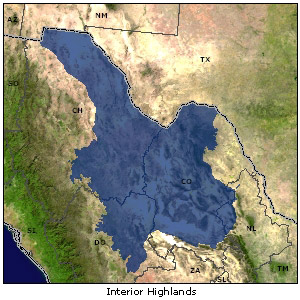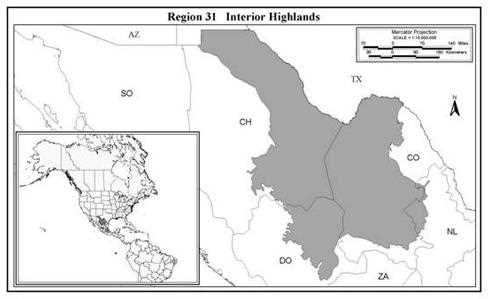Level IV Ducks Unlimited conservation priority area, which accounts for 10 percent of waterfowl wintering in Mexico

The Interior Highlands of Mexico region consists of the Mexican Plateau which slopes gradually from less than 3,000 feet in the north to 5,000-6,500 feet in the south. Sustainable land uses in watersheds are critical, such as the planned development of forestry and agriculture around key wetlands. DU's goal is to strengthen partnerships with state and federal governments and with local and national non-government organizations to support wetland conservation initiatives in the region. DU also serves as a source of information to support decision-making on programs that influence wetlands conservation.


The Interior Highlands (Northern and Central) Region of Mexico (Region 31*) consists of the Mexican Plateau which slopes gradually from less than, 1000 m in the north to 1,500-2,000 m in the south (Leopold 1959). This plateau includes 5 of the physiographic regions outlined by Leopold (1959): Sierra Madre Occidental, Central (Northern) Plateau, Sierra Madre Oriental, Bajio and Volcanic Cordillera. The first three of these areas, which comprise the northern 2/3 of the Mexican Plateau, are combined here as the Northern Highlands. The remaining two, which comprise the southern 1/3 of the Mexican Plateau, are combined as the Central Highlands.
Included within the Mexican Plateau are all, or part of, the states of Chihuahua, Coahuila, Durango, Zacatecas, San Luis Potosi, Aguascalientes, Nayarit, Jalisco, Michoacan, Guanajuato, Queretaro, Mexico, Morelos, Hidalgo, Tlaxcala, Puebla and the Distrito Federal (Leopold 1959).
Three major zones of natural vegetation are defined for the Mexican Plateau (Leopold 1950, 1959):
Wetland vegetation includes both permanent and seasonal marsh communities. There are submerged and floating aquatic vegetation communities and the vegetation bordering lakes, reservoirs and watercourses. Hardstem bulrush, cattail and sedge species characterize permanent marsh communities. Seasonal marsh communities occur in low areas after the summer rains begin. Several species of Cyperus, Carex and Eleocharis are evident as are dense stands of smartweed and grasses such as Echinochloa. Aquatic plants of plateau lakes include species of pondweed, naiad, wigeongrass, coontail, bladderwort and others.
A total of 82,352 ha of wetlands have been classified for the states of Chihuahua and Durango. In Chihuahua there are 52,063 ha, of which 49,114 were lacustrine, littoral, open water systems, that included the areas known as Babicora, Mexicanos Bustillos, Fierro and Redonda and Guzman lagoons as well as other reservoirs and ponds. The remaining 2,474 ha were palustrine emergent habitats (Carrera and de la Fuente 1999). For Durango, 30,288 ha of wetlands were classified, where 25,970 ha are found in the Santiaguillo lagoon, 25,195 are lacustrine open water system, and 775 are palustrine emergent habitats. The rest 4,318 ha of wetlands were scattered around the area under classification (Carrera and de la Fuente 1999).
For the Central Region, the Cuitzeo, Chapala, Cavadas, Languillo and Sayula Lagoons as well as the seasonal fresh water wetlands distributed around the states of Guanajuato, Jalisco and Michoacan provide important habitats for migratory and resident waterfowl.
The original wetlands of the Northern and Central Highlands have been substantially altered or destroyed. Marshland has been diked and drained to increase cropland or to allow urban expansion; water has been diverted or pumped for irrigation, human consumption, power generation and industrial development. Permanent remaining wetlands have been seriously degraded by overgrazing, pollution and siltation, due to the progressive erosion of the surrounding watershed.
Waterfowl surveys in Mexico had been conducted since the early 1950s, by the USFWS and the Mexican Federal Authority. Based on those surveys and the concentration and trend distribution of the waterfowl among the years, 28 key wetlands for waterfowl had been identified, of which seven are in the Interior Highlands. These wetlands; Sayula, Chapala, Cuitzeo (Central Highlands), and Santiaguillo, Mexicanos, Bustillos and Babicora (Northern Highlands), accounted for 10.7% of the waterfowl wintering in Mexico.
Wetlands in the Northern Highlands accounted for 167,705 waterfowl during 1997, of which 70,155 were ducks and 97,550 were geese. Of the ducks, 69,340 were dabblers and 815 divers. Of the dabblers reported, 34,480 were green-winged teal and 22,670 were pintails. Snow/Ross' geese accounted for 87,805 individuals and the remaining 9,745 were white-fronted geese (USFWS 1997).
On the Central Highlands 320,955 waterfowl were reported. Of this total 319,780 were ducks and 1,175 were geese. Of the ducks reported, 293,330 were dabblers, of which 97,670 were green-winged teal, 64,075 northern shoveler, 52,805 pintail and 11,885 Mexican ducks. Of the divers, there were 15,825 canvasback, 6,040 ring-necked duck, 1,950 scaups and 1,405 redhead (USFWS 1997).
From a mid-continent population of white-fronted geese, 200,000 birds use the Northern part of Mexico. This number indicates that 10% occupy the wetlands in the Northern Highlands and the remaining 90% winter on the fresh water wetlands in the state of Tamaulipas. Even though just 10% of this population winters in the Northern Highlands, this region is very important because it supports geese which originate mostly from the Alaskan population, which is on decline (Nieman et al. 1999).
Historically these areas had been the most important habitats for the distribution of the Mexican duck with an average of 19,568 reported from 1951-1997 (USFWS 1997). However this species has fluctuated widely. In 1988, a record 50,000 individuals was reported, in1991 there were less than 10,000. From the total Mexican duck distributed in Mexico, 18% distribute among the Northern Highlands, principally in the states of Chihuahua and Durango and 82% in the Central Highlands, in the states of Jalisco, Guanajuato, Michoacan and Aguascalientes.
*Region 31 - NABCI Bird Conservation Region 35 (Chihuchuan Desert - Mexico only)
The USFWS, 1997 surveys in Mexico, recorded among the Interior Highlands, 60,495 American coot, 13,650 sandhill cranes, 11,450 white pelicans, 9,615 white faced ibis, 6,846 avocets and 5,605 black-necked stilt. In the Northern Highlands there were 14,430 coots, 13,650 sandhill cranes, 820 white pelicans, 120 white-faced ibis, 91 avocets and 30 black-necked stilt. In the Central Highlands, 46,065 coots, 10,630 pelicans, 9,495 ibis, 6,755 avocets and 5,575 stilts were reported.
The Babicora Lagoon in the state of Chihuahua, accounts for 364 species of wildlife and 476 species of vascular plants (Lafon 1996). The Babicora Lagoon, is used by 4 million migratory birds during the spring, and 500,000 during the winter. The average population of waterfowl is 122,000 ducks, geese and cranes. This lagoon represents the most important wintering habitat for the snow goose and the sandhill crane in Mexico, with an annual population of 19,000 snow geese and 25,000 sandhill cranes.
Interior freshwater wetlands are managed by watersheds to protect the natural wetland basins. Sustainable land uses in watersheds are critical such as the planned development of forestry and agriculture plans around key wetlands. Work of this nature is being carried out near Babicora, Chihuahua. with the University of Chihuahua and with the University of Guadalajara in the Cuitzeo Lagoon, Michoacan. In addition, DU should work to protect those key areas for waterfowl. A close interaction with state and federal agencies will be needed to facilitate this effort.
The Interior Highlands have large concentrations of natural depressions used by waterfowl. Because many of these natural habitats have been lost or modified for agriculture uses, conservation of the few remaining natural and created wetlands is crucial for wintering waterfowl. The ini' habitat Initiative is designed to support this need and is directed towards private landowners. This initiative will provide habitat for both wintering and resident waterfowl.
More accurate and systematic waterfowl surveys and habitat evaluation are needed. Although the main areas for waterfowl in Mexico are surveyed every three years, the importance of the habitat in Mexico for waterfowl is underestimated. For example, the recent surveys for white-fronted geese by the USFWS found an average of 20,000 to 25,000 geese on the Northern Highlands. More thorough surveys by the CWS and other Mexican institutions found more than 200,000 birds. Better information is needed to determine the best sites for wintering and resident waterfowl.
A public awareness program is needed within this region, to motivate social participation and involvement, which will facilitate the success of future wetland conservation initiatives.
Ducks Unlimited uses cookies to enhance your browsing experience, optimize site functionality, analyze traffic, and deliver personalized advertising through third parties. By continuing to use this site, you agree to our use of cookies. View Privacy Policy